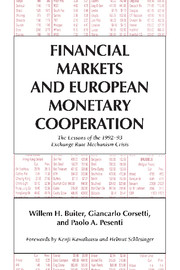 Financial Markets and European Monetary Cooperation
Financial Markets and European Monetary Cooperation Book contents
- Frontmatter
- Contents
- Forewords by Kenji Kawakatsu and Helmut Schlesinger
- Acknowledgments
- 1 Introduction
- 2 Exchange rate stability in Europe: A historical perspective
- 3 The unfolding of the 1992–93 ERM crisis
- 4 Financial markets and ERM credibility
- 5 Modelling currency crises
- 6 A Center–Periphery model
- 7 Unilateral pegs and escape clauses: The role of domestic credibility
- 8 Policy coordination and currency crises
- 9 What caused the system to crumble?
- 10 Rebuilding the system: What next?
- References
- Index
1 - Introduction
Published online by Cambridge University Press: 06 July 2010
- Frontmatter
- Contents
- Forewords by Kenji Kawakatsu and Helmut Schlesinger
- Acknowledgments
- 1 Introduction
- 2 Exchange rate stability in Europe: A historical perspective
- 3 The unfolding of the 1992–93 ERM crisis
- 4 Financial markets and ERM credibility
- 5 Modelling currency crises
- 6 A Center–Periphery model
- 7 Unilateral pegs and escape clauses: The role of domestic credibility
- 8 Policy coordination and currency crises
- 9 What caused the system to crumble?
- 10 Rebuilding the system: What next?
- References
- Index
Summary
Since 1979, the Exchange Rate Mechanism (ERM) of the European Monetary System (EMS) has represented the cornerstone of monetary policy strategies in Europe and the most ambitious experiment in international monetary and exchange rate cooperation of the post-Bretton Woods era. Over the past decade, the nature of the ERM has changed drastically, from a system of fixed but adjustable rates with limited international capital mobility – as originally intended – to the “hard” mechanism implicitly ratified by the Basle-Nyborg agreement in 1987, characterized by stable and narrow target zones and the removal of capital controls.
By the end of the 1980s, the prima facie satisfactory performance of the “hard” ERM enhanced the general appeal of a further transformation of the system toward complete monetary harmonization and eventual unification. The successful conclusion of this transition was heralded as the permanent solution to the problem of inconsistency among national monetary policy objectives under free mobility of commodities, persons, and capital.
Starting in early 1992, however, a sequence of adverse developments of increasing severity seemed to compromise past achievements, as well as to undermine the process towards European Monetary Union (EMU). The crisis and revamping of the ERM between 1992 and 1993 represent the key events in the recent monetary history of Europe. Their origins, consequences, and implications are at the core of the current academic and political debate, both in Europe and elsewhere.
- Type
- Chapter
- Information
- Financial Markets and European Monetary CooperationThe Lessons of the 1992–93 Exchange Rate Mechanism Crisis, pp. 1 - 18Publisher: Cambridge University PressPrint publication year: 1998


